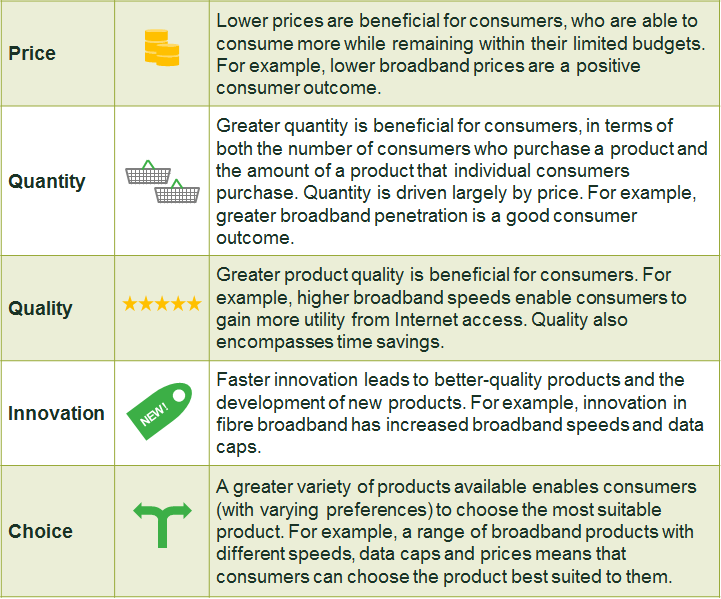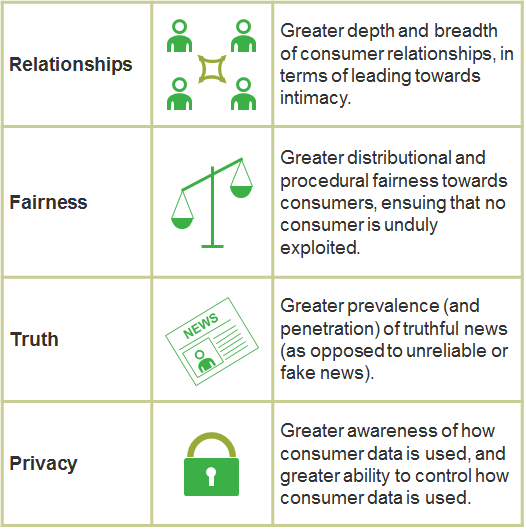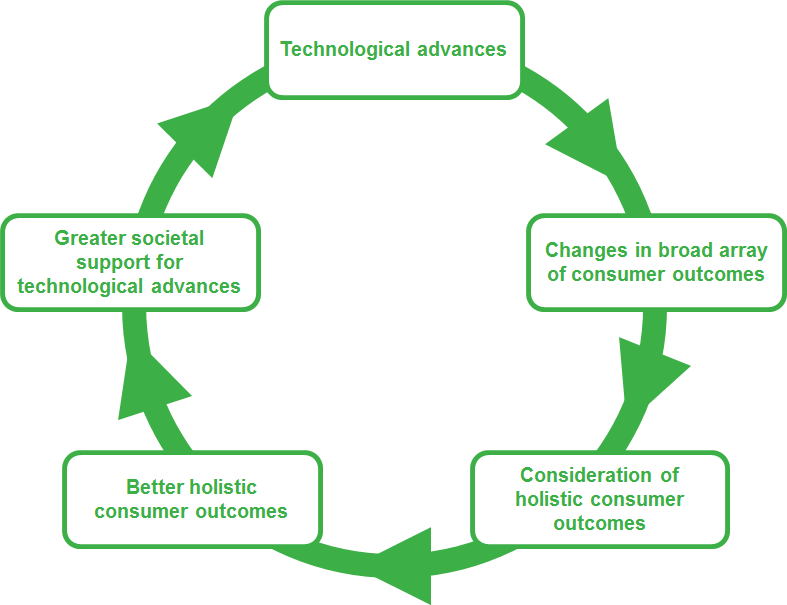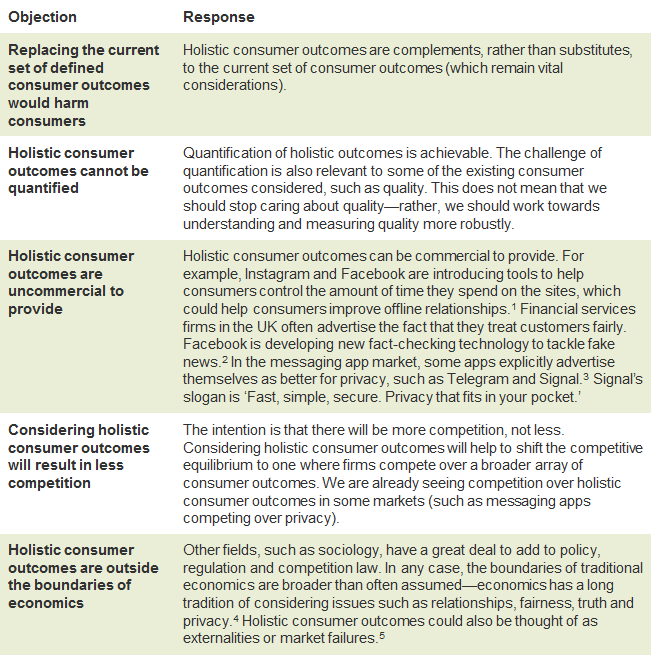Why we need to consider holistic consumer outcomes
As government policy, regulation and competition law all aim to make a positive difference for consumers, it is crucial to have a common understanding of what constitutes a consumer benefit. To date, consumer outcomes have been considered mainly in terms of price, quantity, quality, innovation and choice. However, Tim Hogg, Oxera Senior Consultant, argues that advances in technology mean that authorities should consider an additional set of holistic consumer outcomes, including relationships, fairness, truth, and privacy.
This article is based on Hogg, T. (2018), ‘The Sociology of Technology’, InterMEDIA, International Institute of Communications, January. The article won the 2018 International Institute of Communications Future Leaders Competition. The views in the article are those of the author.
Our common understanding of what constitutes a consumer benefit—i.e. how we define consumer outcomes—is a crucial element in policymaking, regulation and competition law:
- economic impact assessments are conducted to quantify the effects of potential policy decisions;
- if a regulator identifies a market failure causing (sufficiently) poor consumer outcomes, it may choose to enact regulatory remedies;
- competition law has developed to ensure that anticompetitive practices or mergers do not lead to poor consumer outcomes.
Given that consumer outcomes are so important, the way in which they are considered is crucial. There is generally a high degree of consistency in this across policymakers, regulators and competition authorities, as shown in the table below.
Table 1 Five consumer outcomes

Technological advances mean that we need a holistic view of consumer outcomes
The depth and breadth of relationships are being affected by technology
Technology has the ability to bring people together; through social media, we can make new friends and remain in contact with them even if they travel to the other side of the planet.
However, technology can also cause isolation. Loneliness appears to be growing in many societies across the world, and technology may play a role in this for some people.1 Evidence suggests that the loneliest age group in the USA is 18–22, and individuals in this group are arguably likely to be the heaviest users of technology.2 Indeed, therapists advise that switching off devices can deepen intimacy.3
The net effect of technology on the quality of both online and offline relationships is a matter of heated debate.4 Few argue, however, that technology has had little impact on the relationships of billions of consumers.
The fairness of consumer outcomes is being affected by technology
Technology is changing the distribution of consumer outcomes (distributional fairness) and the way in which firms set prices (procedural fairness). Different consumers are quoted different prices for the same goods. Advances in algorithms and access to consumer data mean that personalised pricing is growing in importance.5
While price discrimination is a natural (and often efficiency-enhancing) part of markets, technology is increasing the opportunities for it.6 In many cases, technology is undoing existing cross-subsidies, which may have unintended social consequences. This was highlighted in the UK by a recent complaint to the Competition and Markets Authority from consumer body, Citizens Advice.7
Dissemination of truthful news is being affected by technology
Technology is changing the dissemination of news, with 93% of US adults viewing some form of online news media.8 This is much more convenient (and cheaper) than buying a daily newspaper, and it means that we are often far more aware of global events than we would have been otherwise.
However, the impact of technology has not been totally positive when it comes to the dissemination of news—for example, it has made it easier and cheaper to spread false information (such as ‘fake news’). Fake news undermines trust in online news (and social media platforms) and harms democratic debate.
Privacy is being affected by technology
Technology is changing the level of privacy that consumers enjoy, as many online business models rely on access to consumer data. For example, price comparison websites are able to match us with providers when we enter our personal details and preferences. Social media accounts are often free because of targeted advertising.
The cost to consumers of these positive outcomes is a reduction in privacy.9 This could lead to consumer detriment, as some people may be unaware of how their data is used—and feel powerless to do anything about it.10
Holistic consumer outcomes can and should be considered
New consumer outcomes must be important, quantifiable and widely applicable
One should exercise a certain degree of caution before adding new consumer outcomes to the existing list. Newly considered consumer outcomes should be:
- important to a broad range of consumers, and not overly similar to consumer outcomes already considered;
- quantifiable, in order to be useful in decision-making by policymakers, regulators and competition authorities;
- widely applicable across a broad range of markets, and in the application of policy, regulation and competition law.
The four holistic consumer outcomes in the table below meet these criteria.
Table 2 Holistic consumer outcomes

Relationships
Technology is having a significant impact on the relationships enjoyed by consumers, in both positive and negative ways. Relationships are important to all aspects of the economy, as stated by Ashcroft et al. (2016):11
Creating value, managing risk, achieving performance in a fast-moving business environment, improving wellbeing, building social capital, developing nations: all these challenges are affected by the health or otherwise of relationships.
Perhaps contrary to expectations, the quality of relationships (e.g. intimacy versus loneliness) can be quantified. Five quantifiable metrics have been identified elsewhere as: effective communication; momentum in the relationship (e.g. a sense of belonging); transparency; participation; and synergy (e.g. a shared identity).12
Policymakers are already acting to address some of the issues in relationships that may be exacerbated by technology. For example, in January 2018 the UK appointed a ‘ministerial lead on loneliness’ with responsibility for building ‘more integrated and resilient communities’.13
Consideration of relationships is also widely applicable across the whole economy. As Sir Joseph Pilling, a senior British civil servant, put it:14
It would be a happier world if civil servants were required at the end of every policy paper they wrote to include a paragraph assessing its relational implications for the society they are serving.
To summarise, the depth and breadth of relationships are important, quantifiable, and widely applicable. The relationship consumer outcome can be defined as:
Greater depth and breadth of consumer relationships, in terms of leading towards intimacy or isolation.
Fairness
Technology is affecting distributional and procedural fairness. There is a vast body of evidence from psychology, neuroscience and behavioural economics showing that fairness is important to consumers.15
Distributional and procedural fairness is relevant to all markets where there is price discrimination, and can be considered by policy, regulation and competition law.16 While definitions of fairness are likely to remain to some extent subjective, policymakers and regulators are already beginning to consider fairness. For example, the UK Financial Conduct Authority regulates to ensure that firms are ‘treating customers fairly’, and it is able to quantify and assess fairness.17
Fairness is therefore an important, quantifiable and widely applicable consumer outcome. The fairness consumer outcome can be defined as:
Distributional and procedural fairness towards consumers, ensuing that no consumer is unduly exploited.
Truth
The ability to uncover, proclaim and find truth is a vital part of the democratic process. The truthfulness of online news has come under question with the rise of fake news, and tackling fake news must be a high priority.
Facilitating the truth in online news is already a large part of a range of business models. For example, publishing organisations aim to promote quality in journalism, and online platforms are dealing with the issue, assisted by independent fact-checkers.18 It is possible to define fake news and quantify its prevalence.19
The truthfulness of news is relevant across policy, regulation and competition law. Indeed, policymakers are beginning to take the question of truthfulness in news seriously.
Truth is therefore important and quantifiable. While there could be a debate over whether truth is widely applicable enough (given the focus on news), it should be noted that a variety of online markets, such as social media, affect truth—on balance, it is likely to be applicable in a number of contexts. The truth consumer outcome can be defined as:
Greater prevalence (and penetration) of truthful news (as opposed to unreliable or fake news).
Privacy
Privacy is important to many consumers, although the degree to which they are concerned varies by country.20 The primary concerns about privacy lie in whether consumers are aware of how their data is used, and whether they have control over this.21 Both privacy awareness and control are quantifiable through surveys and experiments and can be evaluated by policymakers.
Privacy is also widely applicable, as it is relevant to all online markets. Indeed, where policymakers and regulators have begun to act on privacy (e.g. the European General Data Protection Regulation), the remedies have been wide-reaching in scope.22
In summary, privacy is important, quantifiable and widely applicable. The privacy consumer outcome can be defined as:
Greater awareness of how consumer data is used, and greater ability to control how consumer data is used.
Considering holistic consumer outcomes will benefit consumers and society
Giving societies flexibility
Holistic consumer outcomes will naturally vary across the world. This flexibility is important and necessary, and it will help to counteract common critiques of globalisation.23
Policymakers, regulators and competition authorities must be fully equipped to take the decisions that will most benefit consumers in their jurisdiction. Each society must reflect on the way in which technology is changing a broad array of consumer outcomes, and select the holistic outcomes that best reflect their own values, preferences and priorities. Considering holistic consumer outcomes will empower societies to ensure that technology benefits all of their consumers.
Creating commercial opportunities
As shown in Figure 1, considering holistic consumer outcomes in policy, regulatory and competition law decisions results in a virtuous circle.
Figure 1 Considering holistic consumer outcomes will create a virtuous circle

Tackling objections
Any proposed change to policymaking, regulation and competition law must be robust to challenge. Table 3 explores five possible objections to considering holistic consumer outcomes, and how these may be overcome.
Table 3 Five objections to considering holistic consumer outcomes

Source: Hogg, T.
Conclusions
The next step is to start an open debate in each society about which holistic consumer outcomes are important, quantifiable and widely applicable. Policymakers, regulators and competition authorities can then begin to define high-level objectives based on these outcomes. These objectives will inform their decisions, and further incentivise enterprises to provide technology-based solutions to the benefit of consumers worldwide.
1 Cai, J. (2018), ‘Loneliness: the latest economic niche opening up in China’, South China Morning Post, 17 February.
2 Cigna (2018), ‘New Cigna study reveals loneliness at epidemic levels in America’, 5 May.
3 Simons, M. (2016), ‘How Technology Affects Our Relationships’, 23 September, welldoing.org.
4 Cohen, M. (2017), ‘Technology and Relationships: The Pros and Cons’, WebMD, 16 April.
5 Mohammed, R. (2017), ‘How Retailers Use Personalized Prices to Test What You’re Willing to Pay’, Harvard Business Review, 20 October.
6Varian, H.R. (2010), Intermediate microeconomics, eighth edition, New York, p. 461.
7 Oxera (2018), ‘Loyal, lazy or time poor?’, 28 September.
8 Pew Research Center (2018), ‘Digital News Fact Sheet’, 6 June.
9 Financial Times (2018), ‘How Big Tech brought back the barter economy’, 18 April.
10 Which? (2018), ‘Control, Alt or Delete? The Future of Consumer Data’, June.
11 Ashcroft, A., Childs, R., Myers, A. and Schluter, M. (2016), The Relational Lens: Understanding, Managing and Measuring Stakeholder Relationships, Cambridge, p. 4.
12 Schluter, M. and Lee, D. (2009), The Relational Manager, Lion Hudson, p. 36.
13 Prime Minister’s Office (2018), ‘PM commits to government-wide drive to tackle loneliness’, press release, 17 January.
14 Cited in Relationships Foundation (2014), ‘Why relationships? Introducing relational thinking’, p. 12.
15 Psychology: Xia, L., Monroe, K.B. and Cox, J.L. (2004), ‘The Price Is Unfair! A Conceptual Framework of Price Fairness Perceptions’, Journal of Marketing, 68, October, pp. 1–15. Neuroscience: Fehr, E. and Krajbich, I. (2014), ‘Social Preferences and the Brain’, in P.W. Glimcher and E. Fehr (eds), Neuroeconomics, second edition, chapter 11, Elsevier. Behavioural economics: Kahneman, D., Knetsch, J.L. and Thaler, R.H. (1986), ‘Fairness as a Constraint on Profit Seeking: Entitlements in the Market’, The American Economic Review, 76:4, September, pp. 728–741.
16 Economics has much to say about fairness. Reiss, J. (2013), Philosophy of economics, New York, p. 255.
17 Financial Conduct Authority (2018), ‘Fair treatment of customers’, 13 February.
18 European Commission (2018), ‘Final report of the High Level Expert Group on Fake News and Online Disinformation’, 12 March.
19 Fletcher, R., Cornia, A., Graves, L. and Nielsen, R.K. (2018), ‘Measuring the reach of “fake news” and online disinformation in Europe’, factsheet, Reuters Institute for the Study of Journalism.
20 Rho, E.H.R., Kobsa, A. and Nguyen, C. (2018), ‘Differences in online privacy and security attitudes based on economic living standards: A global study of 24 countries’, research paper.
21 Oxera (2018), ‘Consumer data in online markets’, prepared for Which?, 5 June, p. 8.
23 For example, ‘the rules under which the governing bodies and authorities work must ensure that they will heed and respond to the desires and needs of all those affected by policies and decisions made in distant places.’ Stiglitz, J. (2002), Globalization and its discontents, New York, p. XV.
Download
Contact
Please get in touch at [email protected]
Contributor
Related
Download
Related

The Independent Water Commission—implications for regulation
This week brought the publication of the Independent Water Commission’s final recommendations for reforming the England and Wales water sector. The report identifies a set of recommendations intended to drive a ‘fundamental reset’ in the industry and restore public trust. In this note, we explore five aspects of the Commission’s… Read More

Why is productivity slowing down—and what does it mean for growth?
Across developed economies—including the UK, France, Japan, and the US—productivity growth has been slowing for decades. This trend appears to contradict the rapid pace of technological innovation, particularly in AI, and the transformative effects of globalisation. So why, despite all this progress, is economic growth falling? In this episode of… Read More
